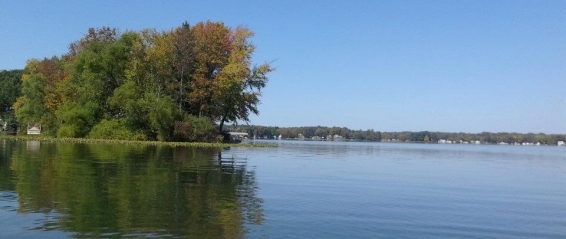2 Foot “Muck” Reduction and 35% Milfoil Reduction Scientifically Proven!
Indian Lake, Michigan
Two year results on “muck” and milfoil in 85 acre South Bay pilot area leads to 500 acre whole lake application in 2012.
PROBLEM
- Excessive invasive Eurasian Watermilfoil
- Toxic blue-green algae blooms
- Reduced water quality
- Approximately 10’ accumulation of decayed organic sediment (muck)
SOLUTION
- Independent 2 year study commissioned by Indian Lake Improvement Association to measure effects of laminar flow Lake Bottom Aeration & Biological Acceleration
- Baseline Water Quality Analysis conducted in June 2010 prior to installation of system
- System installed in 2010
- 2nd Analysis conducted in October of 2010 & 2011 to measure results
RESULTS
- 35% reduction of Eurasian Water Milfoil Density…
- Significant reduction in Harmful Blue-Green algae levels …
- Average 24 inch reduction in Organic Sediment in Study Area over 2 seasons….
- Reduction in Sediment Total Phosphorus…
- 2 foot increase in water clarity.
- Installation of system on entire 500 acre lake in 2012
Indian Lake Restoration Story
Indian Lake in Dowagiac, Michigan is a 500 acre lake deteriorating under the weight of nutrient overloading. The lake is experiencing excessive hybrid weed growth (Eurasian water milfoil), toxic blue-green algae blooms, reduced water quality, and has a substantial sediment accumulation of decayed organic matter (muck) coating the lake-bottom. Previous efforts at controlling weeds included the application of chemical herbicides which proved to be unsatisfactory and unsustainable.
The Study
In 2009 the Indian Lake Improvement Association commissioned an independent 2 year study by Lakeshore Environmental Inc. to measure the effectiveness of Lake Savers’ Lake Bottom Aeration and Biological Acceleration in reducing muck, excess weeds, toxic algal growth, and restoring water quality. An 85 acre test site was selected for the study. The lake association wanted scientific proof that our technology worked before moving forward with a whole-lake restoration plan.
The study was one of the most comprehensive analyses ever conducted of deep-basin laminar flow inversion (Lake Bottom Aeration) and biological augmentation (Biological Acceleration) operating In Situ (in the field). Previous studies of both technologies had only been conducted in laboratory settings.
The 85 acre test site was divided into 4 sections. In one section, only bacterial augmentation (Biological Acceleration) was applied. In another section, only laminar flow inversion (Lake Bottom Aeration) was applied. In a third section, both technologies were used. The fourth section was the control area in which no technology was used.
What was Measured
Over the course of 2 years, changes in water quality, organic sediment thickness, dissolved oxygen levels, phosphorous, nitrogen and other nutrient loading, toxic blue-green algae and aquatic weed growth were measured. Measurements from each test section were then compared.
The Results
In 2011 the study was completed. The data revealed that Lake Bottom Aeration when combined with Biological Acceleration was most effective than each technology used alone. After 2 years, there was a 2’ reduction in sediment organic matter (muck) as well as a “significant” reduction in phosphorus, nitrogen and ammonia, Eurasian water milfoil, pondweed and other nuisance weed species, and toxic blue-green algae (Microcystis). Water quality increased substantially.
The Conclusion
Based on the results, Lakeshore Environmental Inc. strongly suggested that a whole-lake system be put in place to resolve the current issues of nutrient overloading in the rest of the lake. They also explained why chemical herbicides are not the answer…
“Such a system is much preferred over the use of aquatic herbicides which only lead to partial and/or temporary death of aquatic vegetation and cause the damaged vegetation to release phosphorus back into the lake sediments.” _ Lakeshore Environmental Engineering 2011
























